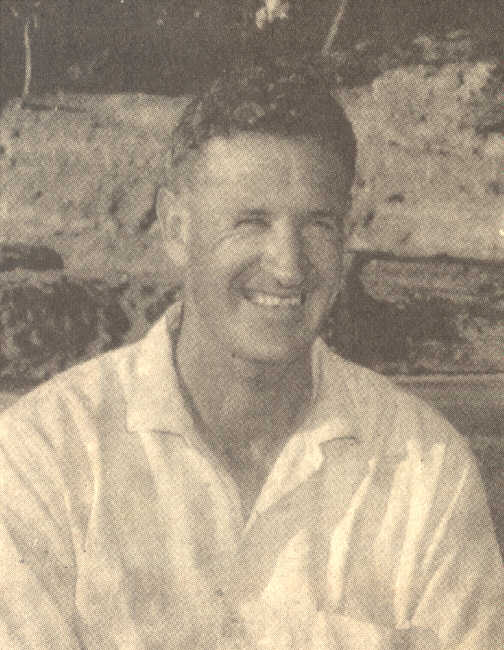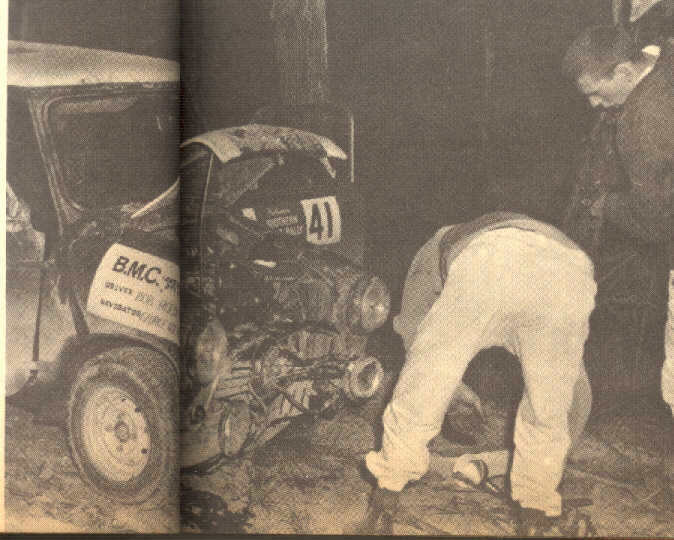|
PIT STOP.
COMPETITION CORNER …. Past & Present.
THE RECORD – BREAKING HOLDEN
 The most wanted driver in Australia today is a casual, sometimes shy 35 year old Sydney man who has always done everything the hard way. The most wanted driver in Australia today is a casual, sometimes shy 35 year old Sydney man who has always done everything the hard way.
It all started when I drove the 1100 Mini Cooper at Amaroo Park. We were testing a light weight Mini when Bob Holden suggested a gallop in his own class winning 1100 around the 1.2miles of Amaroo. Getting out of the lightweight into that was like arriving at the office to find that you are wearing an odd pair of socks. There was not that much difference in sheer poke, for at that time the little 1100 held something like nine class lap records and went almost as hard as a 1310, but the handling was real Mini where the lightweight was quite neutral.
It was in talking afterwards that I realised just how much has led up to this little Castrol green and white shoebox. Bob Holden on serious reckoning, has done more competitive racing and rallying than any man still driving. His experience is absolutely staggering; this is what makes him such good value for a sponsor these days. He can be relied on implicitly to get the utmost out of any car without bending it, shredding the engine, or being over cautious. Holden is thus the busiest man in racing. Holden hadn’t intended to run in the 1100cc class, but because of Castrol he couldn’t really run against Foley in the bigger class. So, he bought the reddest, untidiest Austin Cooper 1071 in Sydney. He did most of the work himself, with the help of Lynx Engineering, and simply followed the well trodden path of Mini development that starts and ends with the BMC spare parts catalogue. The engine was bored to 1098, fully balanced and with the head work it had 13:1 compression. He also fitted a factory straight cut gearbox and a works limited slip diff.
On its first Warwick Farm outing the little car cracked the lap record, and then proceeded to rack up lap records like they were going out of style. The car was timed at 126.76mph down Conrod at the Easter Bathurst race.

All this started for Robert John Holden, now 35, a long time ago. At six years of age in Melbourne he was hit by the 1938 polio epidemic which swept Victoria. It took him three years to recover, but it left him with a crippled right foot that today should stop him driving anywhere near as hard as he does. He can’t heel and toe, must wear special boots and consciously lift his foot from accelerator to brake. He started a career as a trainee civil engineer. As he couldn’t walk very far at the time he started riding a push bike and before long began racing them. In his first race, a 15 mile road race, he beat the champ. He raced bikes until 1954, winning many under 18 events, a 126 miler and the odd six day race until he fell and injured his knees. He was then working for a bike company, racing almost full time.
When Holden had his fall he owned an MGTC, so he joined a car club. That led to the Saturday night treasure hunts and then in 1955, a second hand Peugeot 203. These cars where then a real hotshot for the enthusiast, and it was the first of a long line of Peugeot devices for which Holden is now famous.
The first race meeting he ever saw was at Orange in 1955. He went straight home and fiddled with the 203 engine, succeeding in making it go slower than the standard one. He raced it first at Port Wakefield in South Australia in the Easter of 1955. He spent the next 12 months working on it and learning to drive and finishing fifth in a field of five.
Bob set up a Peugeot engine bolted to the floor. He never use it, just tinkered with it, altered it, modified it until he knew everything he could. Then he bought a new 203-C Peugeot and put everything into it that he had learnt. The car broke class records like straw, and mowed down all the hillclimbs. This last to first transformation was staggering. He also drove in the 1956 (Holden), 1957 (Minx) and 1958 (Peugeot 403) Mobilgas round Australia trials. Boxing day 1957, he ran for the first time a Holden with an ex Repco road test Holden engine. Holden’s Holden won its first race outright.
Bob Holden’s first race at Bathurst was in his 203 in 1957. That year he and a friend drove the 203, with the supercharger removed, from Melbourne to Perth in 36 ½ hours with the Holden race car. Holden ran third in the touring car race there and then packed up and drove home again. At the next Bathurst he sold the Holden to Ron Marshall, known as the fastest rally driver in the country. Marshall asked Bob to drive the black FE for him at the Bathurst race. Holden clocked 121mph down Conrod straight in a big thrash with Barry Gurdon’s blown A95. He ran out of brakes and used Gurdon’s bumper to stop all the way down from Skyline and when Gurdon got to Murray’s he couldn’t work out why he could not stop.
All this time Holden had been paying his own way except for small bonuses from Mobil. When Holden got back to the pits at the end of the race, Marshall gave him the rest of the money for the EH and then drove it home. This cheque helped Bob establish Killara Motor Garage, opening on June 1st 1959. So he stopped racing for 12 months to run the business, specialising in Peugeots of course.
Since 1958 Bob had been using the 403 with which he won his class in the 1958 round Australia. That car ran in the first two Armstrong 500s and the Bathurst Six Hour. When the Austin Lancers came into racing, Holden modified the 403 and had some epic fights with Paul Bolton’s Hillman and Smith’s two Morris Majors. He used the engine as a development basis for the Lynx open wheelers, and the 403 stayed on as a towmaster that used to race with the towbar still attached until he retired it in 1963. That Lynx – Peugeot really made Holden’s name. It was the prototype of the third Lynx; the first being the Tauranac type 500, the second the type Kevin Barlett raced with a BMC A-Series engine. He ran it for three years and it is now winning championship hillclimbs in the hands of Colin Bond.

Bob Holden got back into rallies with the 1964 Ampol Trial, driving with the Gallaher team with Jack Murray and Ron Green. He went overseas with George Reynolds, taking a Cortina GT. They drove it from Bombay to Britain and ran in the Spanish International and came second in class which included five Lotus Cortinas and six Alfas.
Back in Australia, Holden bought a used 997 Mini Cooper for the Bathurst Light Car Club’s rich 1000 Rally, and BMC offered to pay his expenses. He ran second outright. Holden then ran a 1275 S type in Series Production. In the May meeting at Lakeside in 1966 he rolled it. It was his second racing accident.
The first was at Bathurst in 1961 in the FJ. He was dicing with Barry Seton in another Holden and had been worrying about a noise in the diff. He arrived at Skyline and suddenly the revs went sky high and he thought the crown wheel had gone. Actually, a wheel was coming off, and as he coasted into the Esses the wheel passed him, leaving him with no brakes. He kept going down the Esses bouncing off the banks, loosing a second wheel, then spinning it at Forest Elbow. Seaton followed him down, dodging the debris, got a wave to say that Holden was all right, but was so cut up from the whole deal that he rolled his own car in Murrays.
So at Lakeside he had a wrecked Mini on his hands. They trailered it back to Sydney and began stripping it down as Holden left to drive a BMC works car in the BP Rally. BMC organised a body, one that had fallen off the rotordip. As a member for BMC’s rally team he was running for Castrol, but the series production Mini was his and he didn’t really race officially for BMC until he ran the works MGB in the Rothmans 12-hour. He was allocated to partner Rauno Aaltonen in the works team for the Gallaher, which they duly won, sealing Holden’s formidable record of having finished in the endurance events that he entered.
So into the Rothmans Southern Cross for BMC, and he and George Shepheard were up in the top five on the last night when whistled over a brow straight into the spotlight of an official trying to warn of Barry Ferguson’s VW wreckage; result, they hit the same tree. With the front end all mimsy and the steering wheel rubbing on the windscreen, Holden equalled Paddy Hopkirk’s time on one of the last special stages.
But it wasn’t until he smashed John French’s class record at Warwick Farm by three seconds in the new 1100 Mini did Castrol come forward with a fat contract. Holden’s value to a sponsor has finally been irrevocably established. To get to this point in time has taken 10 years and perhaps a million miles of competitive motoring. Who can count them? Certainly not Bob Holden – he’s too busy driving.
That article was an edited version of a story written by Bill Tuckey for Sports Car World August 1967
|